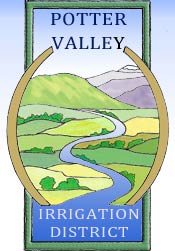Glossary & Index
Acronyms and Agencies
ACOE US Army Corps of Engineers
CDFG California Department of Fish and Game
DFG Department of Fish and Game
FERC The Federal Energy Regulatory Commission (FERC) is responsible for licensing dams, monitoring their safe operation, and minimizing their environmental impact.
FOER Friends of the Eel River
NMFS National Marine Fisheries Service
PG&E Pacific Gas & Electric has owned and operated the Potter Valley Project since 1930, when it was purchased from Snow Mountain Water & Power.
PVID Potter Valley Irrigation District
PVP Potter Valley Project
RPA Reasonable and Prudent Alternative, a 135 page document produced in 2002 by NMFS.
RRFC Mendocino County Russian River Flood Control & Water Conservation Improvement District - they own part of the water rights to Lake Mendocino.
SCWA Sonoma County Water Agency
SWRCB State Water Resources Control Board
USFWS US Fish and Wildlife Service
USFS US Forest Service
USGS The US Geological Survey collects and tracks data about river heights and flows.
Places
Coyote Valley Dam The dam at Lake Mendocino on the Russian River near Ukiah was finished in 1959 and is largely fed by water transferred through the Potter Valley Project.
Cape Horn Dam Cape Horn Dam collects water to feed through the tunnel of the Potter Valley project. The dam and resulting Van Arsdale Reservior is fairly small, unable to provide much water storage. Cape Horn Dam has a fish ladder, allowing the passage of Steelhead and Chinook Salmon, and it is the only point on the entire Eel River system with long term fish count data.
Van Arsdale Reservoir Van Arsdale Reservior is used to collect water to feed into the Potter Valley project. It is fairly small, unable to provide much water storage.
Scott Dam The dam at Lake Pillsbury was completed in 1922 to create summer flows for Potter Valley Project from stored winter rains.
Warm Springs Dam Warm Springs Dam forms Lake Sonoma. It is built on Dry Creek, a tributary of the Russian River.
E-16 diversion E-16 is the gage designation measuring flows from the Eel River into the Potter Valley Project. (see diagram)
E-11 is the gage designation measuring flows in the Eel River below Cape Horn Dam, after the Potter Valley Project diversion. (see diagram)
Units
CFS Cubic feet per second; total acre feet = CFS x 0.082625 AF x hours. Example: 100 CFS x 0.082625 AF x 24 HR. = 198.30 Acre Feet
Acre-foot Enough water to cover an acre with water a foot deep.
Fish & Wildlife
Chinook Salmon
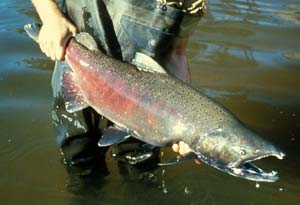 Oncorhynchus tshawytscha are the largest native salmon in Pacific waters. Chinook typically enter the Eel River estuary, when conditions are favorable, beginning in September. They move upriver between storm events and spawn in their natal streams. The adults die after spawning. Alevin remain in the river gravel for about a month after hatching. The fry spend up to six months in the river before they migrate into the estuary, smoltify, and leave the river. Some juvenile Chinook spend several months in the estuary before migrating to the ocean. While in the ocean Eel River Chinook tend to stay relatively close to shore and are known to travel between Monterey on the California coast and as far north as Northern Oregon. Chinook spend up to three years in the ocean before migrating back into the river to spawn.
Oncorhynchus tshawytscha are the largest native salmon in Pacific waters. Chinook typically enter the Eel River estuary, when conditions are favorable, beginning in September. They move upriver between storm events and spawn in their natal streams. The adults die after spawning. Alevin remain in the river gravel for about a month after hatching. The fry spend up to six months in the river before they migrate into the estuary, smoltify, and leave the river. Some juvenile Chinook spend several months in the estuary before migrating to the ocean. While in the ocean Eel River Chinook tend to stay relatively close to shore and are known to travel between Monterey on the California coast and as far north as Northern Oregon. Chinook spend up to three years in the ocean before migrating back into the river to spawn.
Coho Salmon Oncorhynchus kisutch have been observed at the Van Arsdale station 3 times in the last 77 years. They successfully spawn in the Outlet Creek drainage. A significant population of Coho is thought to be located on the South Fork of the Eel. Population numbers are not known through the rest of the Eel River watershed.
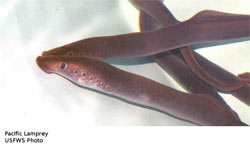 Eels
The "Eels" that the Eel River was named for are actually Pacific Lampreys, an eel-shaped parasite that attaches itself to other fish during its ocean lifecycle.
(Most famously, sharks, but other fish, including salmon, are known hosts.)
Like salmon and steelhead, lampreys are anadromous, meaning they live part of their life in the ocean but return to fresh water to spawn.
They are Cyclostomes (Circle mouths), a primitive fish-like creature, and are not related to eels.
Eels
The "Eels" that the Eel River was named for are actually Pacific Lampreys, an eel-shaped parasite that attaches itself to other fish during its ocean lifecycle.
(Most famously, sharks, but other fish, including salmon, are known hosts.)
Like salmon and steelhead, lampreys are anadromous, meaning they live part of their life in the ocean but return to fresh water to spawn.
They are Cyclostomes (Circle mouths), a primitive fish-like creature, and are not related to eels.
Pikeminnow
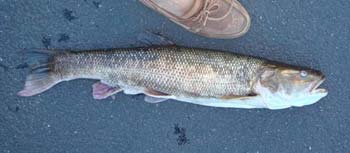 Ptychocheilus grandis, also known as Sacramento Pikeminnow or Sacramento Squawfish, were accidentally introduced to the Eel River system in the 1970s, likely via a bait bucket. They prey on young salmonids and are difficult to control outside their native habitats, which include the Sacramento/San Joaquin and Russian River systems. Read more at fishbase.org or see the USGS Sacramento pikeminnow fact sheet.
Ptychocheilus grandis, also known as Sacramento Pikeminnow or Sacramento Squawfish, were accidentally introduced to the Eel River system in the 1970s, likely via a bait bucket. They prey on young salmonids and are difficult to control outside their native habitats, which include the Sacramento/San Joaquin and Russian River systems. Read more at fishbase.org or see the USGS Sacramento pikeminnow fact sheet.
Steelhead
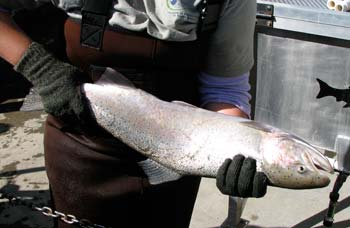 Oncorhynchus mykiss are a sea run phase of rainbow trout. The Eel River has a summer and winter run of steelhead; however, the winter run is the largest and these are the fish we see at the Van Arsdale station on the Mainstem Eel. Steelhead begin to enter the Eel River in November. They spawn in their natal tributaries between February and June. Different from the Chinook salmon, adult steelhead often return to the sea and reenter the river to spawn again in following years. After fertilization the steelhead eggs hatch in about three weeks. Again, as very different from the Chinook salmon, the juvenile steelhead remain in the river for up to four years. These juvenile fish require cool summer temperatures to survive and are often found high in the small shaded tributaries. After living in fresh water, the juvenile steelhead smoltify and move into the estuary for a period of time and then to the ocean. They live two to four years at sea and then return to spawn. Their marine range is unknown because they are rarely caught at sea.
Oncorhynchus mykiss are a sea run phase of rainbow trout. The Eel River has a summer and winter run of steelhead; however, the winter run is the largest and these are the fish we see at the Van Arsdale station on the Mainstem Eel. Steelhead begin to enter the Eel River in November. They spawn in their natal tributaries between February and June. Different from the Chinook salmon, adult steelhead often return to the sea and reenter the river to spawn again in following years. After fertilization the steelhead eggs hatch in about three weeks. Again, as very different from the Chinook salmon, the juvenile steelhead remain in the river for up to four years. These juvenile fish require cool summer temperatures to survive and are often found high in the small shaded tributaries. After living in fresh water, the juvenile steelhead smoltify and move into the estuary for a period of time and then to the ocean. They live two to four years at sea and then return to spawn. Their marine range is unknown because they are rarely caught at sea.
How to identify Coho, Chinook, and Steelhead - from the National Marine Fisheries Service (NMFS)
